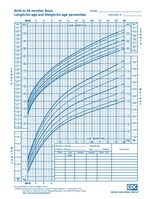
Photo from wikipedia
Background Mowat–Wilson syndrome (MWS; OMIM #235730) is a genetic condition caused by heterozygous mutations or deletions of the ZEB2 gene. It is characterized by moderate-severe intellectual disability, epilepsy, Hirschsprung disease… Click to show full abstract
Background Mowat–Wilson syndrome (MWS; OMIM #235730) is a genetic condition caused by heterozygous mutations or deletions of the ZEB2 gene. It is characterized by moderate-severe intellectual disability, epilepsy, Hirschsprung disease and multiple organ malformations of which congenital heart defects and urogenital anomalies are the most frequent ones. To date, a clear description of the physical development of MWS patients does not exist. The aim of this study is to provide up-to-date growth charts specific for infants and children with MWS. Charts for males and females aged from 0 to 16 years were generated using a total of 2865 measurements from 99 MWS patients of different ancestries. All data were collected through extensive collaborations with the Italian MWS association (AIMW) and the MWS Foundation. The GAMLSS package for the R statistical computing software was used to model the growth charts. Height, weight, body mass index (BMI) and head circumference were compared to those from standard international growth charts for healthy children. Results In newborns, weight and length were distributed as in the general population, while head circumference was slightly smaller, with an average below the 30th centile. Up to the age of 7 years, weight and height distribution was shifted to slightly lower values than in the general population; after that, the difference increased further, with 50% of the affected children below the 5th centile of the general population. BMI distribution was similar to that of non-affected children until the age of 7 years, at which point values in MWS children increased with a less steep slope, particularly in males. Microcephaly was sometimes present at birth, but in most cases it developed gradually during infancy; many children had a small head circumference, between the 3rd and the 10th centile, rather than being truly microcephalic (at least 2 SD below the mean). Most patients were of slender build. Conclusions These charts contribute to the understanding of the natural history of MWS and should assist pediatricians and other caregivers in providing optimal care to MWS individuals who show problems related to physical growth. This is the first study on growth in patients with MWS.
Journal Title: Orphanet Journal of Rare Diseases
Year Published: 2020
Link to full text (if available)
Share on Social Media: Sign Up to like & get
recommendations!